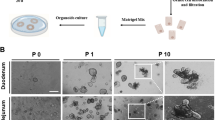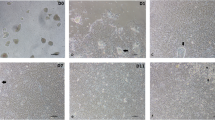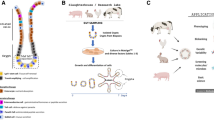Abstract
Intestinal epithelial cells (IECs) not only have an absorption function but also act as a physical barrier between the body and the intestinal bacterial flora. Damage to IECs leads to the breakdown of this barrier and has negative effects on animal health. Intestinal epithelial damage is frequently associated with long-term acute stress, such as increased temperature and new stress management models. The intestinal epithelial damage caused by environmental stress has been linked to oxidative stress. Until now, the effects of intestinal epithelial antioxidant activity from feed additives and treatments could be tested in ducks only in vivo because of the lack of in vitro cell culture systems. In this study, we describe our protocol for the easy isolation and culture of IECs from the small intestine of duck embryos. Immunofluorescence was used for the cytological identification of IECs. In addition, IEC marker genes (IAP and CDH1) could also be detected in cultured cells. And cell status assessments were performed, and cell proliferation viability was analyzed by CCK-8 assay. Furthermore, we constructed an oxidative stress model to be used to research the oxidative stress response mechanism, and drugs acting on the cell signal transduction pathway. In conclusion, we have developed an effective and rapid protocol for obtaining duck primary IECs and constructed an oxidative stress model. These IECs exhibit features consistent with epithelial cells and could be used to explore the physiological mechanisms of oxidative stress ex vivo.







Similar content being viewed by others
References
Bao D, Wang J, Pang X, Liu H (2017) Protective effect of quercetin against oxidative stress-induced cytotoxicity in rat Pheochromocytoma (PC-12) cells. Molecules 22:E1122
Batlle E, Sancho E, Francí C, Domínguez D, Monfar M, Baulida J, García DHA (2000) The transcription factor snail is a repressor of E-cadherin gene expression in epithelial tumour cells. Nat Cell Biol 2:84–89
Booth C, Evans GS, Potten CS (1995) Growth factor regulation of proliferation in primary cultures of small intestinal epithelium. In Vitro Cell Dev Biol Anim 31:234–243
Chandler JS, Calnek D, Quaroni A (1991) Identification and characterization of rat intestinal keratins. Molecular cloning of cDNAs encoding cytokeratins 8, 19, and a new 49-kDa type I cytokeratin (cytokeratin 21) expressed by differentiated intestinal epithelial cells. J Biol Chem 266:11932–11938
Chiva M, Guarner C, Peralta C, Llovet T, Gómez G, Soriano G, Balanzó J (2003) Intestinal mucosal oxidative damage and bacterial translocation in cirrhotic rats. Eur J Gastroenterol Hepatol 15:145–150
Cosgun BE, Erdeml ME, Gul M, Gul S, Bag HG, Aksungur Z, Altinoz E (2018) Crocin protects intestine tissue against carbon tetrachloride-mediated oxidative stress in rats. Gen Physiol Biophys 37:399–409
D’Yvoire MB, Bremer S, Casati S, Ceridono M, Coecke S, Corvi R, Eskes C, Gribaldo L, Griesinger C, Knaut H (2012) ECVAM and new technologies for toxicity testing. Adv Exp Med Biol 745:154–180
Gan QZ, Sun XY, Bhadja P, Yao XQ, Ouyang JM (2016) Reinjury risk of nano-calcium oxalate monohydrate and calcium oxalate dihydrate crystals on injured renal epithelial cells: aggravation of crystal adhesion and aggregation. Int J Nanomedicine 11:2839–2854
Grabinger T, Luks L, Kostadinova F, Zimberlin C, Medema JP, Leist M, Brunner T (2014) Ex vivo culture of intestinal crypt organoids as a model system for assessing cell death induction in intestinal epithelial cells and enteropathy. Cell Death Dis 5:e1228
Gu XH, Hao Y, Wang XL (2012) Overexpression of heat shock protein 70 and its relationship to intestine under acute heat stress in broilers: 2. Intestinal oxidative stress. Poult Sci 91:790–799
Guo L, Li R, Zhang YF, Qin TY, Li QS, Li XX, Qi ZL (2018) A comparison of two sources of methionine supplemented at different levels on heat shock protein 70 expression and oxidative stress product of Peking ducks subjected to heat stress. J Anim Physiol Anim Nutr (Berl) 102:e147–e154
Higashiguchi T, Hasselgren PO, Wagner K, Fischer JE (1993) Effect of glutamine on protein synthesis in isolated intestinal epithelial cells. Jpen 17:307–314
Hodin RA, Chamberlain SM, Meng S (1995) Pattern of rat intestinal brush-border enzyme gene expression changes with epithelial growth state. Am J Phys 269:385–391
Jean-Paul L (2010) Intestinal alkaline phosphatase: multiple biological roles in maintenance of intestinal homeostasis and modulation by diet. Nutr Rev 68:323–332
Jia Y, Guan Q, Guo Y, Du C (2012) Echinacoside stimulates cell proliferation and prevents cell apoptosis in intestinal epithelial MODE-K cells by up-regulation of transforming growth factor-β1 expression. J Pharmacol Sci 118:99–108
Jin Y, Peng Y, Liu F, Cheng G, Guo K, An L, Zhu X, Luan W, Xu J (2010) Effect of heat stress on the porcine small intestine: a morphological and gene expression study. Comp Biochem Physiol A Mol Integr Physiol 156:119–128
Kaiser A, Willer T, Steinberg P, Rautenschlein S (2017) Establishment of an in vitro intestinal epithelial cell culture model of avian origin. Avian Dis 61:229–236
Kaser A, Niederreiter L, Blumberg RS (2011) Genetically determined epithelial dysfunction and its consequences for microflora-host interactions. Cell Mol Life Sci 68:3643–3649
Kimmich GA (1970) Preparation and properties of mucosal epithelial cells isolated from small intestine of the chicken. Biochemistry 9:3659–3668
Lin X, Jiang S, Jiang Z, Zheng C, Gou Z (2016) Effects of equol on H2O2-induced oxidative stress in primary chicken intestinal epithelial cells. Poult Sci 95:1380–1386
Mei C, He SS, Yin P, Xu L, Shi YR, Yu XH, An L, Liu FH, Jiang LS (2016) Magnolol pretreatment attenuates heat stress-induced IEC-6 cell injury. J Zhejiang Univ Sci B 17:413–424
Muscella A, Vetrugno C, Fanizzi FP, Manca C, Pascali SAD, Marsigliante S (2013) A new platinum (II) compound anticancer drug candidate with selective cytotoxicity for breast cancer cells. Cell Death Dis 4:e796
Patrick L, Marie-Josée L, Marie-Josée B, Christian J, Nathalie R (2004) Down-regulation of MEK/ERK signaling by E-cadherin-dependent PI3K/Akt pathway in differentiating intestinal epithelial cells. J Cell Physiol 199:32–39
Pothier P, Hugon JS (1980) Characterization of isolated villus and crypt cells from the small intestine of the adult mouse. Cell Tissue Res 211:405
Reiisi S, Esmaeili F, Shirazi A (2010) Isolation, culture and identification of epidermal stem cells from newborn mouse skin. In Vitro Cell Dev Biol Anim 46:54–59
Sato T, Vries RG, Snippert HJ, Wetering MVD, Barker N, Stange DE, Es JHV, Abo A, Kujala P, Peters PJ (2009) Single Lgr5 stem cells build crypt–villus structures in vitro without a mesenchymal niche. Nature 459:262–265
Shan T, Shan T, Liu F, Zheng H, Li G (2017) Effects of Lycium barbarum polysaccharides on the damage to human endometrial stromal cells induced by hydrogen peroxide. Mol Med Rep 15:879–884
Suzuki T (2013) Regulation of intestinal epithelial permeability by tight junctions. Cell Mol Life Sci 70:631–659
Tian G, Liang X, Chen D, Mao X, Yu J, Zheng P, He J, Huang Z, Yu B (2016) Vitamin D3 supplementation alleviates rotavirus infection in pigs and IPEC-J2 cells via regulating the autophagy signaling pathway. J Steroid Biochem Mol Biol 163:157–163
Wang J, Hu G, Lin Z, He L, Xu L, Zhang Y (2014) Characteristic and functional analysis of a newly established porcine small intestinal epithelial cell line. PLoS One 9:e110916
Wang JM, Gu Y, Pan CJ, Yin LR (2017) Isolation, culture and identification of human adipose-derived stem cells. Exp Ther Med 13:1039–1043
Wilson LM, Baldwin AL (2015) Environmental stress causes mast cell degranulation, endothelial and epithelial changes, and edema in the rat intestinal mucosa. Microcirculation 6:189–198
Wu B, Cui H, Peng X, Fang J, Zuo Z, Deng J, Huang J (2013) Dietary nickel chloride induces oxidative intestinal damage in broilers. Int J Environ Res Public Health 10:2109–2119
Yang Y, Wu ZZ, Cheng YL, Lin W, Qu C (2019) Resveratrol protects against oxidative damage of retinal pigment epithelium cells by modulating SOD/MDA activity and activating Bcl-2 expression. Eur Rev Med Pharmacol Sci 23:378–388
Yu J, Yao H, Gao X, Zhang Z, Wang JF, Xu SW (2015) The role of nitric oxide and oxidative stress in intestinal damage induced by selenium deficiency in chickens. Biol Trace Elem Res 163:144–153
Zhan K, Lin M, Liu MM, Sui YN, Zhao GQ (2017) Establishment of primary bovine intestinal epithelial cell culture and clone method. In Vitro Cell Dev Biol Anim 53:54–57
Zhao GH, Liu Y, Cheng YT, Zhao QS, Qiu X, Xu C, Xiao T, Zhu S, Liu GZ, Yin K (2018) Primary culture of cat intestinal epithelial cells in vitro and the cDNA library construction. Acta Parasitol 63:360–367
Zou Y, Wei HK, Xiang QH, Wang J, Zhou YF, Peng J (2016) Protective effect of quercetin on pig intestinal integrity after transport stress is associated with regulation oxidative status and inflammation. J Vet Med Sci 78:1487–1494
Acknowledgments
This work was supported by grants from the National Natural Science Foundation (Grant numbers: 31702157), the Hubei Provincial scientific and technological innovation special project (Grant Numbers: 2017ABA140) and China Agriculture Research System (Grant Numbers: CARS-42-47), and Hubei Academy of Agricultural Sciences Younger Top-Notch Talent Program (Grant Numbers: Q2018021). Animal slaughter followed the Ethics Committee of the Institute of Hubei Academy of Agricultural sciences.
Author information
Authors and Affiliations
Corresponding author
Ethics declarations
All animal experiments were approved and carried out in accordance with the Animal Care and Use Committee of Hubei Academy of Agricultural Sciences and in accordance with the principles and guidelines of the National Institutes of Health.
Additional information
Editor: Tetsuji Okamoto
Rights and permissions
About this article
Cite this article
Zhang, H., Chen, F., Liang, ZH. et al. Isolation, culture, and identification of duck intestinal epithelial cells and oxidative stress model constructed. In Vitro Cell.Dev.Biol.-Animal 55, 733–740 (2019). https://doi.org/10.1007/s11626-019-00388-7
Received:
Accepted:
Published:
Issue Date:
DOI: https://doi.org/10.1007/s11626-019-00388-7




